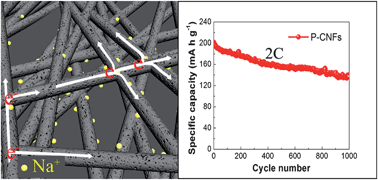Free-standing and binder-free sodium-ion electrodes with ultralong cycle life and high rate performance based on porous carbon nanofibers†
Abstract
Free-standing and binder-free porous carbon nanofibers (P-CNFs) electrodes were prepared by pyrolysis of PAN-F127/DMF nanofibers via an electrospinning process as potential anodes for Na-ion batteries (NIB). The P-CNFs delivers a reversible capacity of 266 mA h g−1 after 100 cycles at 0.2 C, corresponding to ∼80% of the initial charge capacity. When cycled at a current density as high as 500 mA g−1 (2 C), it still delivers a reversible capacity of ∼140 mA h g−1 after 1000 cycles. The improvement of electrochemical performance is attributed to the special design and microstructure of P-CNFs, which conferred a variety of advantages: hierarchical porous channels enabling short transport length for ions and electrons, 3D interconnected structure resulting in low contact resistances, good mechanical properties leading to the excellent morphology stability.


 Please wait while we load your content...
Please wait while we load your content...